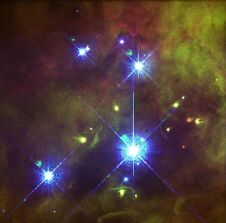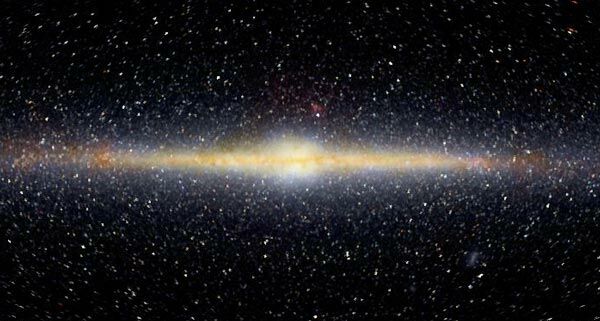Galaxy POX 186
(an "ultracompact" blue dwarf)

Galaxy POX 186 |  | |
| Home | X-Objects | Stars | Habitability | Life | |
 Michael
Corbin, William
Vacca,
Michael
Corbin, William
Vacca,
CSC, STScI,
MPE,
NASA
Larger image
(4,200 light-years wide).
POX 186 is a very small galaxy with many bluish
young stars as well as harder-to-detect older stars.
It is located about 68.5 million light-years away in
the direction of Constellation Virgo (more from
STScI
and
Astronomy
Picture of the Day).
Blue Compact Dwarf Galaxies
With around 10 million stars and measuring less than 1,000 light-years (ly) -- 300 parsecs (pc) -- across, POX 186 is extremely small by galaxy standards. By contrast, the Milky Way galaxy is now thought to be at least 120,000 ly across (including a recently discovered outer disk ring) and contains around 400 billion stars -- plus or minus 200 billion. POX 186 appears to be an "ultracompact" example of a class of galaxies called Blue Compact Dwarfs because of their small size and conspicuous abundance of hot blue stars (some images from astronomer John Hibbard and his colleagues).
 Rogier
Windhorst, Sam Pascarelle,
Rogier
Windhorst, Sam Pascarelle,
Arizona State
University,
STScI,
NASA
Larger true-color image of ultraviolet
emission redshifted to visible light.
Early galaxies about 11 billion years
ago tended to be small, bluish, and
peculiarly shaped
(more).
Within the class of dwarf galaxies, Blue Compact Dwarfs (BCDs) appear to be dominated by a recent burst of star formation, which creates their unusually blue colors. Some astronomers have proposed that some of these galaxies (the lowest metallicity ones) may be very young objects that are experiencing their first large burst of star formation. Some also suspect that BCDs represent an evolutionary stage in dwarf galaxies generally, a stage in which strong ongoing star formation activity promotes galactic winds that transform can a gas-rich dwarf irregular into a gas-poor dwarf spheroidal galaxy (more on early dwarf irregular galaxies). Tending to be bluish and small, many early proto-galaxies that were recently detected across over at least 12 billion light-years exhibit rapid star formation (converting as much as 100 Solar-masses of gas per year into stars), about 100 times the rate found in the Milky Way today (more on early star formation).
 Wolfgang
Brandner,
Eva K. Grebel,
Wolfgang
Brandner,
Eva K. Grebel,
and
You-Hua Chu,
STScI,
NASA
Larger field image.
Blue irregular galaxies have a conspicuous
abundance of very young and hot, massive
blue stars, such as those found in NGC
3603, at left
(more).
Although most galaxies such as the Milky Way may have formed billions of years ago, POX 186 appears to be reaching galaxy size only now, possibly because it is located about 68.5 million light-years (ly) away from Sol in a region of comparatively empty space known as a void that is about 30 million ly across. Within the Virgo Supercluster of galaxies that includes the Milky Way, its nearest galactic neighbors are still about 30 million light-years (ly) away. As a result, the two small clumps of gas and stars that are merging to form POX 186 may have taken longer to be drawn together by gravity than similar clumps in denser regions of space. Its oldest stars may only be around one billion years old, which is young on the cosmic time scale.
 John Bally,
Dave Devine, and
John Bally,
Dave Devine, and
Ralph Sutherland,
STScI,
NASA
Larger false-color image.
Like the four bright central stars of the
Trapezium
Cluster in Orion, most of the
hot blue stars in blue compact dwarf
galaxies are massive and short-lived B-
and O-type stars
(more).
POX 186
This "ultracompact" irregular galaxy of relatively low metallicity is located in the direction of (13:25:50.0–11:37:36.0, J2000) of Constellation Virgo. Its prefix "POX " is derived from the French for "prism objectif" (objective prism), a device that astronomers place in front of a telescope to photograph the spectra of all objects in its field of view. Some other designations for the galaxy are LEDA 46982 and PGC 046982.
POX 186 was discovered over 20 years ago (Kunth et al, 1981), but ground-based telescopes had resolved few details of the galaxy's structure because of its small size. Some astronomers have detected an old stellar population in an extended faint halo that underlies the younger "starburst" components of POX 186, of which three "super star clusters" (SSCs) of young blue stars in the inner region of the galaxy are most prominent (Doublier et al, 2000). The largest star cluster lies in a compact central region that measures roughly 33 to 49 ly (10 to 15 pc) across with around 100 million Solar-masses, out of a total of around 10 billion Solar-masses for entire galaxy (Corbin and Vacca, 2002).

Vanessa
Doublier, Daniel Kunth,
Frederic Courbin, and
Pierre Magain,
NTT,
ESO
(Used with permission from Courbin)
Larger contoured image.
The innermost region of POX 186
is composed of three major "super
star clusters" (more discussion
and images are available from
Doublier
et al, 2000).
According to Michael R. Corbin of STScI and William D. Vacca of the Max Planck Institute for Extraterrestrial Physics) who imaged POX 186 with the Hubble Space telescope in 2002, the emerging galaxy's youthfulness is suggested by the abundance of newborn stars and its disturbed shape, which is highly asymmetric with a tail of material that includes recently born stars on its western side that may be tidal in origin. POX 186 appears to have a misshapen arch of stars on one side, which may be a telltale sign of recent merger activity. The knot of vigorous star birth at the galaxy's core is also not usually seen in old galaxies. Eventually, gravity will eventually pull in the new galaxy's stars together into a more symmetrical form.
 Y. Izotov
(MAO),
Y. Izotov
(MAO),
T. Thuan
(UVA),
ESA,
NASA
Larger image.
A larger but closer relative
of Pox 186 is
I
Zwicky 18,
which is located only 45
million ly away (more from
hubblesite.org
and
APOD).
Most of the star formation in the galaxy is concentrated in the compact central region, where new stars are being born every twenty-some years. The outer regions of POX 186 are significantly redder than the central cluster, with colors consistent with a a stellar population dominated by late K- and early M-type, main sequence dwarf and giant stars indicating that previous episodes of star formation have already occurred. Although these findings rule out earlier speculation that POX 186 is a protogalaxy, its structure, small mass and size, and high star-forming activity suggest that it may have been created from the collision of two smaller clumps of gas and stars of sub-galactic size (of around 300 ly or 100 pc across) less than 100 million years ago, which is usually extremely recent given that the universe may be 15 billion or more years old (Corbin and Vacca, 2002).
 Hubble
Heritage Team
Hubble
Heritage Team
(STScI /
AURA),
M. Tosi
et al,
ESA,
NASA
Larger image.
More than twice the size of
POX 186 at around 2,000 ly
across, NGC 1705 is a 13-
billion-year-old dwarf
irregular galaxy with a
recent burst of star
formation that lies only
about 17 million ly away
(more from
APOD).
The youthful galaxy's small size appears to support a recent theory of galaxy formation known as "downsizing," which proposes that the least massive galaxies in the universe are the last to form (Corbin and Vacca, 2002; 2001; and 2000). In contrast to POX 186, the most massive galaxies in the universe are giant ellipticals, which have a generally spherical structure with few or no young stars because they must have formed many billions of years in the past. Most large galaxies, such as our Milky Way, are thought to have formed the bulk of their stars billions of years ago. The discovery of POX 186 supports theories that all galaxies originally formed through the assembly of smaller "building blocks" of gas and stars, most of which formed shortly after the Big Bang all energy and matter in the universe. Tiny galaxies, not massive ones, should arise last because it takes gravity much longer to condense the sparse bits of matter in relatively voids.

Edward
L. Wright,
COBE,
DIRBE,
NASA -- larger infrared image
(Although the Milky Way began forming over 10 billion years
ago, POX 186 is just reaching minimal galaxy size --
more.)
Other Information
HI Imaging of Blue Compact Dwarfs are available from from astronomer John Hibbard and his colleagues. Astronomer Polichronis Papaderos also has some images of distant Blue Compact Dwarf Galaxies.
More information and images of these galaxies may be available at NASA and IPAC's Extragalactic Database.
|
© 2003-2004 Sol Company. All Rights Reserved. |